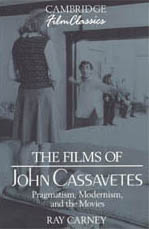This
page describes the press response to Prof. Carney's discovery of the long
version of Faces in 2001. To read about that discovery, click
here.
To
read a chronological listing of events between 1979 and the present connected
with Ray Carney's search for, discovery of, and presentation of new material
by or about John Cassavetes, including a chronological listing of the
attempts of Gena Rowlands's and Al Ruban's to deny or suppress Prof. Carney's
finds, click
here.
Click
here for best printing of text
THE HOLLYWOOD REPORTER,
DECEMBER 13, 2002 ON RAY CARNEY'S DISCOVERY OF THE LONG VERSION OF FACES:
Unearthing
a 'lost' John Cassavetes film
By Pat Nason
UPI Hollywood Reporter
> From the Life & Mind Desk
Published 12/13/2002
LOS ANGELES, Dec. 13 (UPI)
-- Film historians are analyzing the value of a "lost" version
of "Faces," the breakthrough 1968 movie by the late John
Cassavetes, which was recently discovered in the Library of Congress
film archive.
Ray Carney -- professor of
Film and American Studies, director of the graduate and undergraduate
Film Studies Programs, and chair of graduate admissions for Film Studies
at Boston University -- made the discovery recently, when he noticed
a discrepancy in the Library of Congress online catalogue of archived
films. On top of everything else, Carney is an expert on the life and
work of Cassavetes, and the independent film movement that the actor
helped popularize in the 1960s.
 According
to a news release issued by Boston University, Carney "had a gut
feeling something was amiss" when the online catalogue listed one
copy of "Faces" as 18 minutes longer than the others. Library
staffers told Carney it was probably a clerical error, but he decided
to travel to Washington to be sure. According
to a news release issued by Boston University, Carney "had a gut
feeling something was amiss" when the online catalogue listed one
copy of "Faces" as 18 minutes longer than the others. Library
staffers told Carney it was probably a clerical error, but he decided
to travel to Washington to be sure.
As soon as he started to screen
the print, Carney said he knew he had discovered a historic "lost" version
of the movie, one that Cassavetes may have meant to be released theatrically.
"The evidence from the
credits alone was so conclusive, and I was so excited, that I stopped
the film before the first scene had appeared on screen and told (library
staffers) what they had sitting in storage unknown to them for so many
years, waiting to be discovered," said Carney.
According to the university's
release, Carney has written five books on Cassavetes and knows "Faces" cold
-- shot-by-shot. He manages a web site devoted to the filmmaker at
www.Cassavetes.com.
The discovery is exciting
for Cassavetes fans and film preservationists in general, said Ken
Wlaschin, director of Creative Affairs at the American Film Institute
in Los Angeles.
"Because John Cassavetes
isn't with us anymore and this is one of his most important films,
this is fascinating," said Wlaschin. "He had a lot of trouble
editing this movie. The original cut, I understand was six hours long.
He probably made a number of different versions. It will be interesting
to see how he changed it."
"Faces" -- a drama
about the dissolution of a middle-aged couple's marriage -- was widely
regarded at the time of its release as the first non-commercial movie
to be embraced by a mass American audience. Starring Cassavetes' wife,
Gena Rowlands, the film was nominated for three Oscars -- including
original screenplay (Cassavetes), supporting actor (Seymour Cassel)
and supporting actress (Lynn Carlin). The National Society of Film
Critics honored Cassavetes with is best screenplay prize and named
Cassel best supporting actor.
According to Carney, the movie
went through at least five completely different assemblies, and it
was widely thought that Cassavetes had destroyed all the alternative
versions once he settled on the final release print.
"The location of an alternate
version is of clear historical importance," said Carney. "It
seems likely that it represents one of Cassavetes' final versions;
in fact, it may have been intended to be the release version. It's
no exaggeration to compare this discovery to finding a version of 'Citizen
Kane' with a new beginning and a different shot selection."
 Wlaschin
said the discovery underscores the importance of film preservation. Wlaschin
said the discovery underscores the importance of film preservation.
"The interesting thing
is that archives like the Library of Congress, UCLA, and so on, are repositories
of the past," he said. "You can, years after an artist has passed
on, see something that they did."
Cassavetes died in 1989 at
the age of 59, after spending nearly 40 years in film as an actor,
director, screenwriter, and producer. The IFP Independent Spirit Awards,
the top honors in the independent film world, include a John Cassavetes
Award -- presented to the writer, director and producer of the best
feature made for under $500,000.
Cassavetes wrote and directed
nine feature films, including "A Woman Under the Influence" (1974), "Husbands" (1970)
and "Shadows" (1959). His acting credits included "Rosemary's
Baby" (1968) and "The Dirty Dozen" (1967).
Carney's most recent book
on the filmmaker, "Cassavetes on Cassavetes," was published
in 2001.
Copyright 2002 United Press
International
This
page describes the press response to Prof. Carney's discovery of the long
version of Faces in 2001. To read about that discovery, click
here.
To
read a chronological listing of events between 1979 and the present connected
with Ray Carney's search for, discovery of, and presentation of new material
by or about John Cassavetes, including a chronological listing of the
attempts of Gena Rowlands's and Al Ruban's to deny or suppress Prof. Carney's
finds, click
here. |










